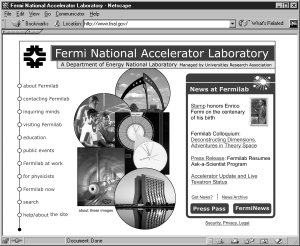 |
|
New Fermilab Website Marks First Anniversary by Mike Perricone
The interactive map is one of many new features added since the introduction of the new website design one year ago, on March 1, 2001. The debut of the website coincided with the official start of Collider Run II of the Tevatron, Fermilab’s experimental run offering great hopes for expanding the current map of the particle physics landscape.
The new website has also sent out a beacon for new visitors. For the first time, visitors from outside the Fermilab domain now outnumber internal visitors. The notable shift occurred during January, 2002 according to tracking figures analyzed by Xeno Media, the Chicago-area design firm that revamped the Fermilab website.
“We began taking statistics on users in June, 2001,” said Kevin Munday of Xeno, which also consults on maintaining and updating the website. “At first, it was typically 60 percent internal users and 40 percent external visitors. Then in January, we started to see a shift to where most of the visits came from outside the lab. Now it’s just over 50 percent. Looking at the public areas of the website, the overall traffic is up from both internal and external visitors, with the biggest gains coming from outside the lab.”
In fact, visits to the website have increased almost 40 percent since Xeno began keeping the statistics. There were just over 40,000 visits during the week of June 3; in the first week of February, that number topped 55,000 for the first time. To provide context, Xeno uses a standard for visits that counts connections from specific computers, servers or proxy servers; there is another standard called “unique visitors,” which Munday describes as “almost always inflated” because the same person dialing in twice from the same source would be counted as two “unique” visitors.
Visits per week statistics June 2001-January 2002
The visitors, as might be expected, are more numerous on weekdays than on weekends. But there is a somewhat surprising wrinkle in what brings visitors to the site, when analyzed by the key words used by search engines to link to Fermilab.
“The prevalent key words are anything related to particle physics, and birds,” Munday explained. “There is a whole realm of nature-related key words that generates a lot of traffic. Peter Kasper’s bird pages get a lot of traffic generated by search engines. And that always seems to be the case.”
Once visitors reach the site, most head toward a core list of major attractions. Munday reported that any items featured in the home page News Box, such as press releases or Arts Series events, invariably receive many visits. The periodic Accelerator Updates are always popular, giving visitors an insight into the daily activities of the Tevatron and the lab’s entire accelerator complex. The Virtual Tour generally receives 200 to 300 visits per week. Other popular locations are FERMINEWS, the Inquiring Minds and the Science of Matter, Space and Time pages, Physics Questions, and the Enrico Fermi biography page.
Mieke van den Bergen of Fermilab Public Affairs, who maintains and updates the website on a daily basis, said there have been very few complaints about difficulties with navigation.
“Occasionally, someone writes that something is hard to find,” said Van den Bergen. “But most of the comments we’ve received have been quite positive.”
There have been several significant additions since the launch of the website. There is now a timeline of high-energy physics, which Munday described as “more graphic than many other web presen-tations of similar material.” The presentation of “PULSE: Accelerator Science in Medicine” represents the first use of Macromedia Flash technology to provide animation on the Fermilab public website. Visitors can view live particle collisions from the control rooms of the CDF and DZero detectors. They can also order brochures online. And the first “Virtual Ask-A-Scientist” session was held early in February, offering a “chat room” with two Fermilab physicist handling on-line questions.
As in any new project, especially in science and technology, the regard of peers offers a measure of success. Since the new web site was launched, other physics labs have inquired about some of the technical considerations and innovations that went into the redesign.
While the visitor statistics don’t reveal who is actually using the Fermilab website—whether a high school student or a Nobel Prize winner— the web offers great potential for gathering information in the future, if there are questions that lend themselves to public surveys.
“Fermilab is in the enviable position of not selling anything,” Munday said. “So people visiting the site might be pretty open to offering us feedback.”
On the web:
|
 A redesigned website has put Fermilab on the map.
The new interactive map provides an overall view of the Fermilab site with a “zoom-in” function for high-traffic and high-concentration areas. A mark of the new map’s reception: Fermilab’s security representatives have been handing out printed copies of the new web map when greeting visitors at the Lederman Science Education Center.
A redesigned website has put Fermilab on the map.
The new interactive map provides an overall view of the Fermilab site with a “zoom-in” function for high-traffic and high-concentration areas. A mark of the new map’s reception: Fermilab’s security representatives have been handing out printed copies of the new web map when greeting visitors at the Lederman Science Education Center.